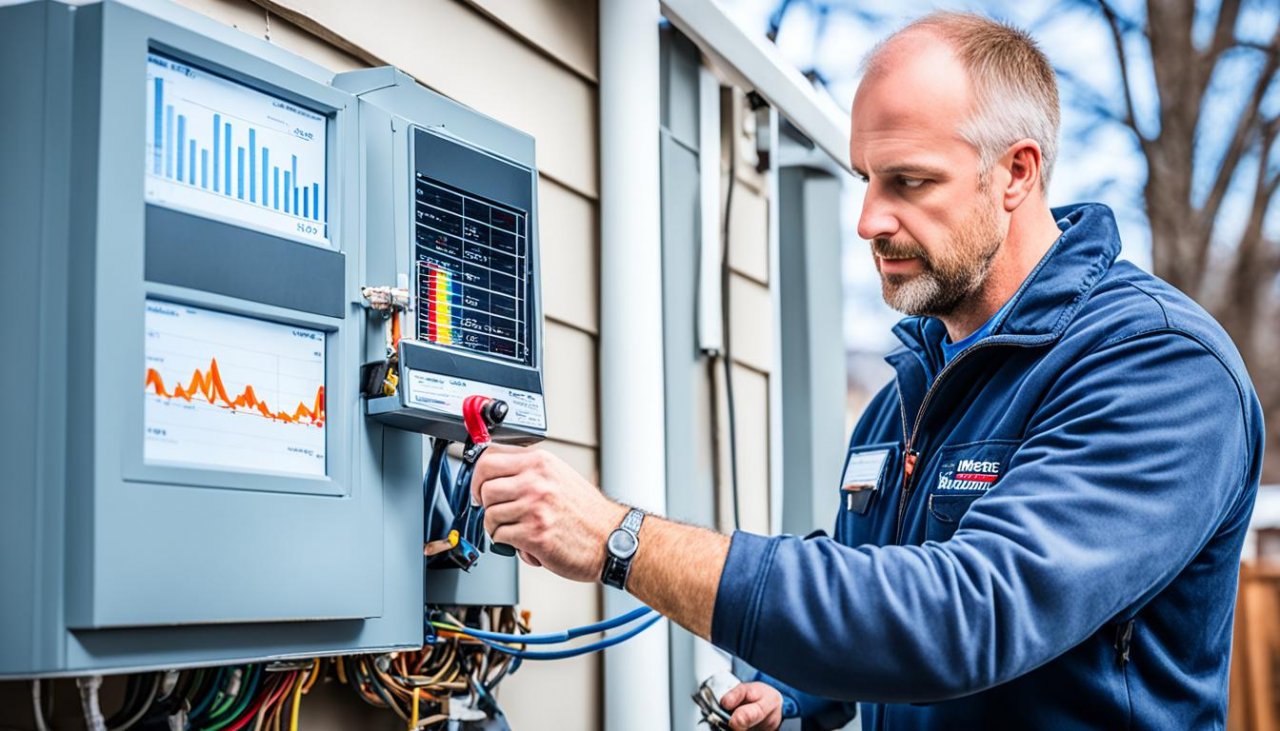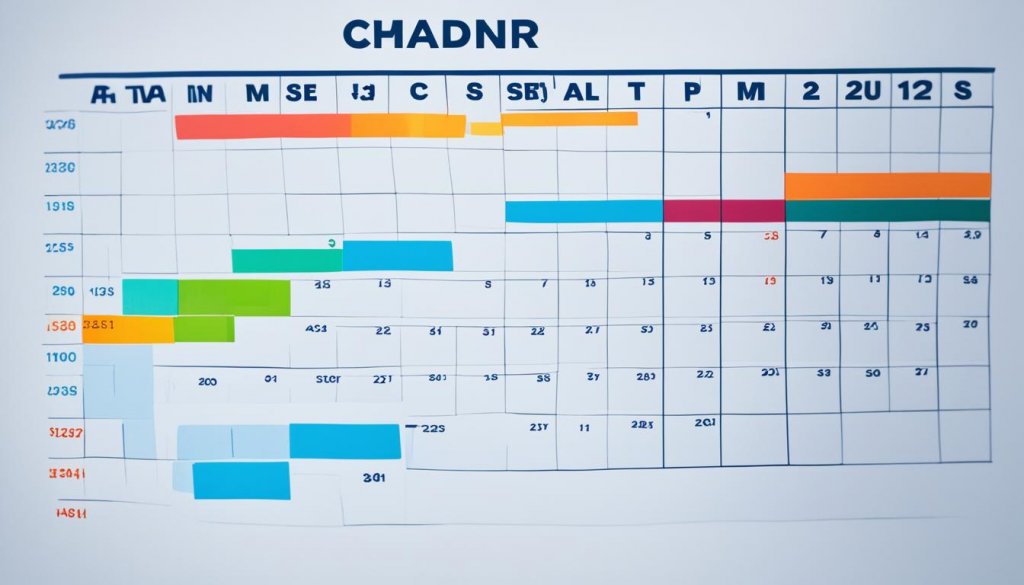Have you ever thought about how HVAC companies do well in hot summers and cold winters but struggle in quiet months? These ups and downs in demand greatly affect their work and profits. I’m going to look into how HVAC companies handle these changes. They use special strategies to keep their services steady all year.
Learning about HVAC demand forecasting and managing peak seasons is key to doing well. By sharing these strategies, I hope to show how HVAC companies can keep their services steady all year.

Key Takeaways
- Seasonal demand can lead to a surge in work orders and maintenance requests for HVAC businesses.
- Slow seasons impact workflow and revenue; effective management solutions are crucial.
- Robust inventory management helps predict needs and prevent stockouts.
- Healthy cash flow during off-peak seasons is vital for sustained operations.
- Preventive maintenance scheduling aids in resource allocation and service continuity.
- Adaptable pricing strategies enhance competitiveness and customer satisfaction.
- Communication with customers and proactive marketing can mitigate demand fluctuations.
Understanding Seasonal Changes in the HVAC Industry
The HVAC industry sees big changes with the seasons. In summer, the heat makes energy use go up and bills higher. If cooling systems don’t work well, it can make people uncomfortable and unhappy at work.
In winter, it’s the opposite; not enough heat makes things cold. Severe cold can even cause pipes to freeze and water damage, which is very costly.
Knowing how to handle these seasonal changes is key. Regular checks on HVAC systems help with airflow and save energy. Using smart thermostats helps me keep an eye on energy use and cut costs.
Choosing energy-efficient HVAC gear cuts down on costs and keeps temperatures steady. Good insulation is also key for comfort and less strain on HVAC systems. Making sure the air inside is clean is important for everyone’s health and comfort.
Getting ready for the seasons helps save energy. Forecasting HVAC demand lets me plan for changes. Working with experts on maintenance keeps my systems running well all year, making sure everyone stays comfortable and saves money.
Significance of Seasonal Demands
The demand for HVAC services changes a lot with the seasons. This affects how much work and profit there is. In summer and winter, when the weather is extreme, there’s a big increase in requests for air conditioning and heating systems.
This makes it crucial to understand these trends. It helps businesses get ready and use their resources well. By knowing about HVAC seasonal demand, we can plan ahead and offer deals or change prices to meet what customers need.
Even though managing these cycles is hard, adapting well can open up new chances for growth. For example, families might spend more during tax season, which means more HVAC requests. Watching how consumers act helps us offer services that fit what people want right now.
By being proactive and changing our plans, we can keep doing well in the HVAC market.
Challenges Faced During HVAC Slow Seasons
In the HVAC industry, slow seasons usually hit in the fall and spring. These periods bring challenges that can make things tough. With fewer people needing heating and cooling, there’s less demand for services. This drop affects cash flow and can slow down growth.
Managing my HVAC team becomes key during these times. It’s hard to keep skilled technicians on board when work is scarce. I need to find ways to keep them happy and employed.
Keeping the right amount of inventory is hard when there’s less need for services. Offering home maintenance plans can help keep money coming in regularly. These plans bring in steady fees each year.
Homeowners who keep these plans going for at least two years can bring in a lot more money. This approach helps me build strong customer ties, even when times are slow.
Using software like ServiceTitan helps me manage maintenance agreements better. It makes things run smoother. Talking well with customers and my team is crucial for loyalty, especially in slow times. Keeping my team motivated and informed keeps morale up and service consistent when demand picks up again.
Benefits of Adaptable Pricing Strategies for HVAC
Adapting pricing strategies in the HVAC industry can greatly improve business performance. During high demand periods, I can charge more for my services. This is because customers need them more urgently. In slow months, I offer discounts to bring in new customers and keep services steady.
Using advanced HVAC service scheduling software is key. It helps me match prices with the current market. With dynamic pricing, I can make customers happier and keep my services competitive all year.
Knowing about geographic factors is important for pricing. Places with extreme weather often see HVAC costs go up because of high demand. Cities add more complexity with higher living costs affecting my business expenses.
Having a strong strategy means carefully looking at my costs. I need to know all the expenses of my HVAC business. This lets me set prices that are fair yet competitive. By checking my processes and getting better deals, I can cut costs and increase profits.
Flexible pricing helps me avoid charging too little or too much. This way, I can make more money when it’s busy and increase sales when it’s slow. Also, by understanding what customers want, I can make my services more appealing to them.
Key Features in HVAC Management Software
As I explore the HVAC industry’s seasonal demands, I see how crucial the right software is. A good system makes tasks easier and lets me focus on great customer service. At the heart of this are scheduling and dispatching tools like drag-and-drop, route optimization, and real-time tracking. These features help me run my service smoothly and quickly answer customer calls.
Going digital with admin tasks saves time and cuts down on paperwork. I love the easy-to-use interface of my HVAC software. It makes getting around simple and cuts down on mistakes in data entry. This means my techs can quickly find customer info and job details anywhere, making them more efficient.
Managing inventory is key to avoiding too much stock and having the right parts ready. Accurate tracking boosts customer happiness and lowers costs. With detailed service histories, I can spot recurring problems and fix them faster.
Tracking maintenance helps me keep up with equipment and plan for upkeep. Live demos show how HVAC software can make my work easier, lower costs, and give me an edge in the market.
Inventory Management Capabilities
Managing HVAC inventory well is key to handling seasonal demand. When customers show more interest during holidays or extreme weather, having the right stock is crucial. Using advanced software helps me keep track of stock and predict what I’ll need next.
Automated alerts for reordering help avoid running out of stock when it’s busy. This makes sure I always have what customers need.
When it’s busy, working with logistics companies is important. They help me stay quick to respond to seasonal changes. By looking at trends and market research, I can plan better to meet customer needs.
Improving how I store and ship items helps my supply chain run well, even when it’s busy. This means I can keep up with demand without any problems.
Creating special bundles and hiring extra staff during busy times helps me sell more and keep customers happy. I also make sure I have enough space and organize my storage well to handle more items.
Using the latest in inventory tracking lets me handle orders fast and right, even when demand goes up. Investing in making my supply chain better is key to my business doing well. It helps me deal with the ups and downs of the seasons.
Cash Flow Tracking and Management
For those in the HVAC industry, keeping a healthy cash flow is key, especially in slow seasons. Using strong HVAC cash flow management helps keep my business stable all year. Tools like advanced invoicing software make billing easier and help me keep track of payments.
Having separate business accounts makes managing money simpler. It lets me track my income and expenses better. By negotiating flexible credit lines, I can handle the ups and downs of seasonal demand. This way, I can make smart choices for my business’s future.
Using software like QuickBooks has been a game-changer. It keeps my finances accurate and lets me easily make reports. I can see how profitable I am and manage my assets well. By tracking cash flow, I can plan for both good and bad times.
Technology also helps with managing money coming in. Tools like Payzerware make sure I always have enough cash to run my business smoothly. Staying on top of my finances has helped my business grow and succeed in a changing market.
Importance of Preventative Maintenance Scheduling
Having a strong HVAC maintenance coordination plan is key for businesses in areas with harsh weather. Regular checks every month are crucial. These include inspecting cooling systems, cleaning coils, and checking refrigerant levels. It also means clearing drain lines and swapping out filters. This way, businesses can stop their HVAC systems from breaking down and avoid sudden issues.
Companies that get their HVAC checked twice a year, in fall and spring, stay ahead. They make sure heating systems work well and cooling systems are set for summer. I’ve seen how a good maintenance plan can cut down on stress, save money, and keep things running smoothly all year.
Looking after HVAC systems means they last longer and use less energy. This can cut energy bills a lot. It means less trouble for customers and cleaner air for everyone. With companies like React Industries offering top-notch HVAC solutions since 1983, sticking to a maintenance plan makes a big difference in our field.

By focusing on HVAC maintenance, I can cut down on emergency breakdowns a lot. Regular checks for leaks and filter changes help keep systems running well. Using a Computerised Maintenance Management System (CMMS) makes tracking maintenance easier. This ensures every step towards better efficiency is followed up on.
Enhancing Efficiency with Service Software
In the HVAC industry, making things run smoother is key, especially when demand goes up and down. Service software helps a lot with this. It makes managing work orders, scheduling jobs, and dispatching better. This means customers get faster service and are happier.
Technicians love the mobile access they get with this software. They can get updates and talk to customers easily through portals. This makes things run smoother for everyone, especially when there’s a lot of work to do.
Automated scheduling is a big win for me. It cuts down on double bookings and long waits, making my team’s work easier. Tools like ServiceM8 help me manage my team and keep costs down when it’s busy. They send out updates and keep all customer info in one place, making things run better.
Using these technologies makes my HVAC business run better. It helps me handle the ups and downs of the season with ease. This keeps my customers happy, which is good for my business and the quality of service I offer.
Strategies for Efficient Workflow Management
Managing workflow well is key in my HVAC business, especially when demand changes with the seasons. I use HVAC technician dispatching to sort service calls by urgency and customer needs. This way, urgent calls get fast attention, making customers happier.
Geographic scheduling cuts down on travel time for my technicians. This lets them work more efficiently. By planning service calls by location, we reduce downtime and make balancing workloads easier. Being flexible with schedules helps us quickly adapt to changes, meeting customer needs fast.
Matching technicians with jobs that match their skills speeds up fixing problems and cuts down on follow-up calls. Assigning tasks based on skill makes my team work faster and more accurately. Also, keeping customers updated on service times reduces wait times and improves their experience.
Using advanced software for route planning has cut down on travel time a lot. This makes my service delivery more efficient. With real-time tracking and communication, I make customers happier and keep my service reliable and high-quality.
By improving these strategies, I can handle workloads well in busy and slow seasons. This keeps my HVAC business profitable and my customers happy.
HVAC Seasonal Demand Management Best Practices
Managing seasonal demand in the HVAC industry means being proactive. Offering home maintenance plans is a great way to keep a steady income all year. In slow months, tweaking marketing can draw in new customers. Training employees when it’s quiet helps them get ready for the busy times.
Staying in touch with clients is key to keeping them loyal. This way, they think of me when they need HVAC services. Using advanced software makes things run smoother and helps with managing seasonal demand. It also makes sure technicians are where they need to be when demand goes up.
A Job Card Management System keeps track of the team’s work in real-time. This helps meet deadlines and keeps technicians on schedule. A quick quote template saves time and stops customers from going elsewhere.
Managing inventory right is crucial. It prevents running out of parts or having too many. This ensures I always have what customers need.
Route planning with Vehicle Tracking Software cuts down on travel time for technicians. This means they can do more work. Automating tasks frees up time for helping customers. Faster invoicing with Invoice Software means less chance of late payments and better cash flow.
Getting feedback from customers is important. It helps see how happy they are and find ways to get better during the busy times.
Navigating Through Fluctuating Demand
Handling the ups and downs of HVAC service demand means being flexible and planning ahead. Seasonal changes affect customer needs, making it key to keep customers interested during slow times. By offering special deals during these periods, we keep our customers thinking about us and their HVAC systems.
This strategy builds strong relationships with our clients and keeps our business steady with HVAC service scheduling. The COVID-19 pandemic changed how people spend money, making them cut back on HVAC services. Now, supply chain problems often lead to part shortages, making it hard to quickly help our customers.
To keep our business stable, we’re looking into new services and working with other contractors. This helps us handle the ups and downs in demand better. When prices go up, we might need to adjust our service costs to keep customers coming back.
Marketing in new ways can really boost interest in our HVAC services. Using online ads, social media, and customer stories helps spread the word. By keeping an eye on trends and using demand forecasting tools, we can plan better and improve how we schedule our services.

Conclusion
Looking at HVAC seasonal demand management, it’s clear that a strategic approach is key. Using advanced analytics and machine learning for forecasting can improve demand accuracy. This could cut stockouts and excess inventory by up to 20%. Such precision can change how my HVAC business works and makes it more efficient.
Also, working together on forecasting improves communication and boosts inventory turnover rates. I could see an increase of 15-30%. These strategies help me get ready for each season. They also help manage inventory better, focusing on high-value products to boost revenue.
By staying in touch with customers and adapting to new trends, I can meet the market’s changing needs. With the right tools and strategies, my HVAC services can do well even when demand changes. This leads to sustainable growth for the future.
See how FieldAx can transform your Field Operations.
Try it today! Book Demo
You are one click away from your customized FieldAx Demo!
FAQ
How can HVAC businesses effectively manage seasonal demand?
HVAC businesses can manage seasonal demand by using strategies like demand forecasting and management software. Understanding seasonal trends helps them adjust to changes in service requests. This keeps operations consistent.
What are some challenges HVAC companies face during slow seasons?
In slow seasons, HVAC companies struggle with cash flow, keeping skilled technicians, and managing inventory. Talking openly with customers and employees, and smart resource use can help overcome these issues.
Why is pricing strategy important in the HVAC industry?
Pricing strategies help HVAC businesses make the most of peak season demand with higher prices. They also attract customers in slow periods with discounts. This flexibility keeps service flow steady and ensures profits all year.
What features should I look for in HVAC management software?
Look for features like scheduling, real-time job tracking, automated dispatching, and inventory management in HVAC software. These tools streamline operations and improve service efficiency in all seasons.
How does inventory management contribute to HVAC seasonal demand management?
Good inventory planning helps HVAC companies keep an eye on stock, predict needs, and send out reorder alerts. This ensures they meet customer demands quickly without extra costs during seasonal changes.
What role does preventative maintenance scheduling play in HVAC profitability?
Regular maintenance scheduling is key for longer equipment life and happier customers. It cuts down on emergency calls and builds strong customer relationships. These are crucial for steady revenue through seasonal shifts.
How can HVAC businesses improve operational efficiency?
Using service software to manage work orders, dispatch technicians, and talk to customers improves efficiency. This leads to faster responses and better service during busy times.
What best practices can HVAC businesses adopt for seasonal demand management?
HVAC businesses should promote maintenance plans, adjust marketing in slow periods, and train employees when it’s quiet. Keeping in touch with customers all year builds loyalty and increases service requests when demand goes up.
How can HVAC companies navigate demand fluctuations effectively?
Seasonal promotions, maintenance contracts, and demand forecasting help HVAC businesses keep customers engaged and ready for seasonal changes.
Author Bio
Co-Founder & CMO at Merfantz Technologies Pvt Ltd | Marketing Manager for FieldAx Field Service Software | Salesforce All-Star Ranger and Community Contributor | Salesforce Content Creation for Knowledge Sharing






